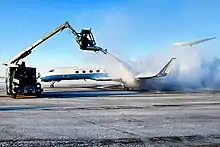Industrial stormwater
Industrial stormwater is runoff from precipitation (rain, snow, sleet, freezing rain, or hail) that lands on industrial sites (e.g. manufacturing facilities, mines, airports). This runoff is often polluted by materials that are handled or stored on the sites, and the facilities are subject to regulations to control the discharges.
Regulation in the United States

In the United States, facilities that discharge industrial stormwater to surface waters must obtain a permit under the National Pollutant Discharge Elimination System (NPDES), pursuant to the Clean Water Act.[1] Stormwater permit regulations issued by the United States Environmental Protection Agency (EPA) govern the permit process.[2] EPA published its "Phase I" stormwater rule, which covers industrial dischargers, in 1990.[3]
Most stormwater permits in the U.S. are issued by the agencies in 47 states that have been given authority by EPA. EPA regional offices issue the stormwater permits in the remaining parts of the country.[4]
Multi-sector general permit
EPA published its Multi-Sector General Permit (MSGP) initially in 1995 to govern how industrial stormwater should be managed, and periodically it has updated and reissued the permit. The 2015 MSGP covers 29 industrial and commercial sectors:[5]
- Timber Products Facilities (including wood preservation)
- Paper and Allied Products Manufacturing Facilities
- Chemical and Allied Products Manufacturing and Refining
- Asphalt Paving and Roofing Materials and Manufacturers and Lubricant Manufacturers
- Glass, Clay, Cement, Concrete, and Gypsum Product Manufacturing Facilities
- Primary Metals Facilities
- Metal Mining (Ore Mining and Dressing) Facilities
- Coal Mines and Coal Mining-Related Facilities
- Oil and Gas Extraction Facilities
- Mineral Mining and Processing Facilities
- Hazardous Waste Treatment, Storage, or Disposal Facilities
- Landfills and Land Application Sites
- Automobile Salvage Yards
- Scrap Recycling and Waste Recycling Facilities
- Steam Electric Power Generating Facilities, including Coal Handling Areas
- Motor Freight Transportation Facilities, Passenger Transportation Facilities, Petroleum Bulk Oil Stations and Terminals, Rail Transportation Facilities, and United States Postal Service Transportation Facilities
- Water Transportation Facilities with Vehicle Maintenance Shops and/or Equipment Cleaning Operations
- Ship and Boat Building or Repair Yards
- Vehicle Maintenance Areas, Equipment Cleaning Areas, or Deicing Areas Located at Air Transportation Facilities
- Sewage treatment plants
- Food and Kindred Products Facilities
- Textile Mills, Apparel, and Other Fabric Products Manufacturing Facilities
- Wood and Metal Furniture and Fixture Manufacturing Facilities
- Printing and Publishing Facilities
- Rubber, Miscellaneous Plastic Products, and Miscellaneous Manufacturing Industries
- Leather Tanning and Finishing Facilities
- Fabricated Metal Products Manufacturing Facilities
- Transportation Equipment, Industrial, or Commercial Machinery Manufacturing Facilities
- Electronic and Electrical Equipment and Components, Photographic, and Optical Goods Manufacturing Facilities

The permit is applicable to facilities in Massachusetts, New Hampshire, New Mexico, Idaho, the District of Columbia and federal insular areas (territories). The other states have developed their own state-specific industrial stormwater permits (e.g. California's Industrial General Permit).[6] State-issued general permits often include the same requirements as EPA's permit, but some states have additional requirements. Idaho will take over stormwater permit authority from EPA in 2021.[4]

Construction site stormwater
Under EPA regulations, stormwater runoff from construction sites is also classified as industrial stormwater, however these discharges are covered by a separate set of permits. EPA periodically publishes its Construction General Permit and the approved state agencies publish similar permits, to regulate discharges from construction sites of 1 acre (4,000 m2) or more.[7] In addition to implementing the NPDES requirements, many states and local governments have enacted their own stormwater management laws and ordinances, and some have published stormwater treatment design manuals.[8][9] Some of these state and local requirements have expanded coverage beyond the federal requirements. For example, the State of Maryland requires erosion and sediment controls on construction sites of 5,000 sq ft (460 m2) or more.[10]
See also
References
- United States. Federal Water Pollution Control Amendments of 1972. Pub.L. 92-500, October 18, 1972; as amended by the Water Quality Act of 1987, Pub.L. 100-4, February 4, 1987. Section 402(p), 33 U.S.C. § 1342(p).
- United States Environmental Protection Sgency (EPA), Washington, D.C. "Storm water discharges." EPA Administered Permit Programs: The National Pollutant Discharge Elimination System. Code of Federal Regulations, 40 CFR 122.26.
- EPA (1990-11-16). "National Pollutant Discharge Elimination System Permit Application Regulations for Storm Water Discharges". Federal Register, 44 FR 47990.
- "NPDES State Program Information". National Pollutant Discharge Elimination System (NPDES). EPA. 2019-04-27.
- "Stormwater Discharges from Industrial Activities". NPDES. EPA. 2019-02-14.
- "Industrial Storm Water Program". State Water Resources Control Board. California Environmental Protection Agency. 2016-03-22.
- "Stormwater Discharges from Construction Activities". NPDES. EPA. 2018-12-12.
- Washington State Department of Ecology (August 2012). Olympia, WA. "Stormwater Management Manual for Western Washington." Publication No. 12-10-030.
- Maryland Stormwater Design Manual (Report). Baltimore, MD: Maryland Department of the Environment. 2009.
- State of Maryland. Code of Maryland Regulations (COMAR). Activities for Which Approved Erosion and Sediment Control Plans are Required. Sec. 26.17.01.05.